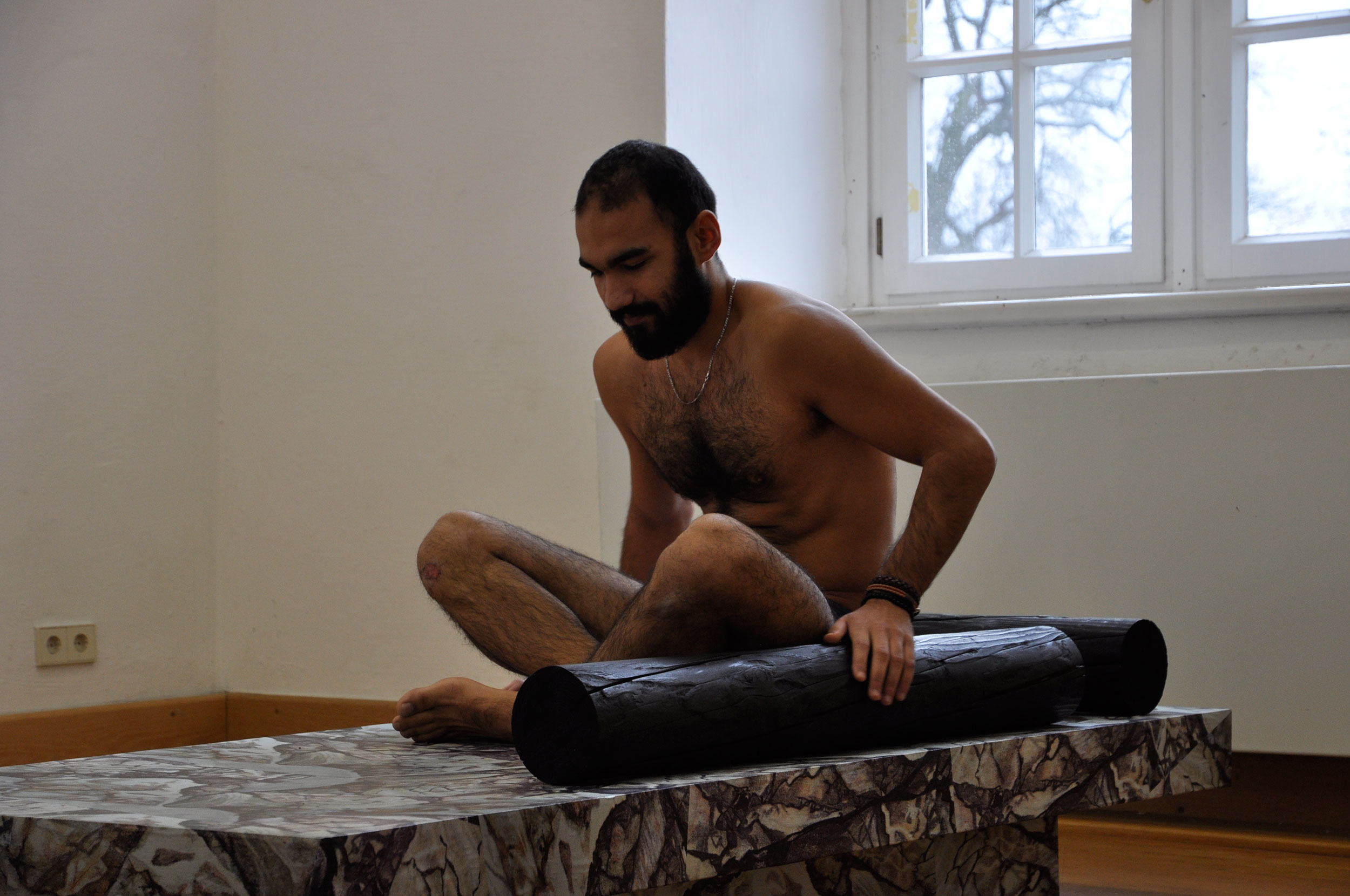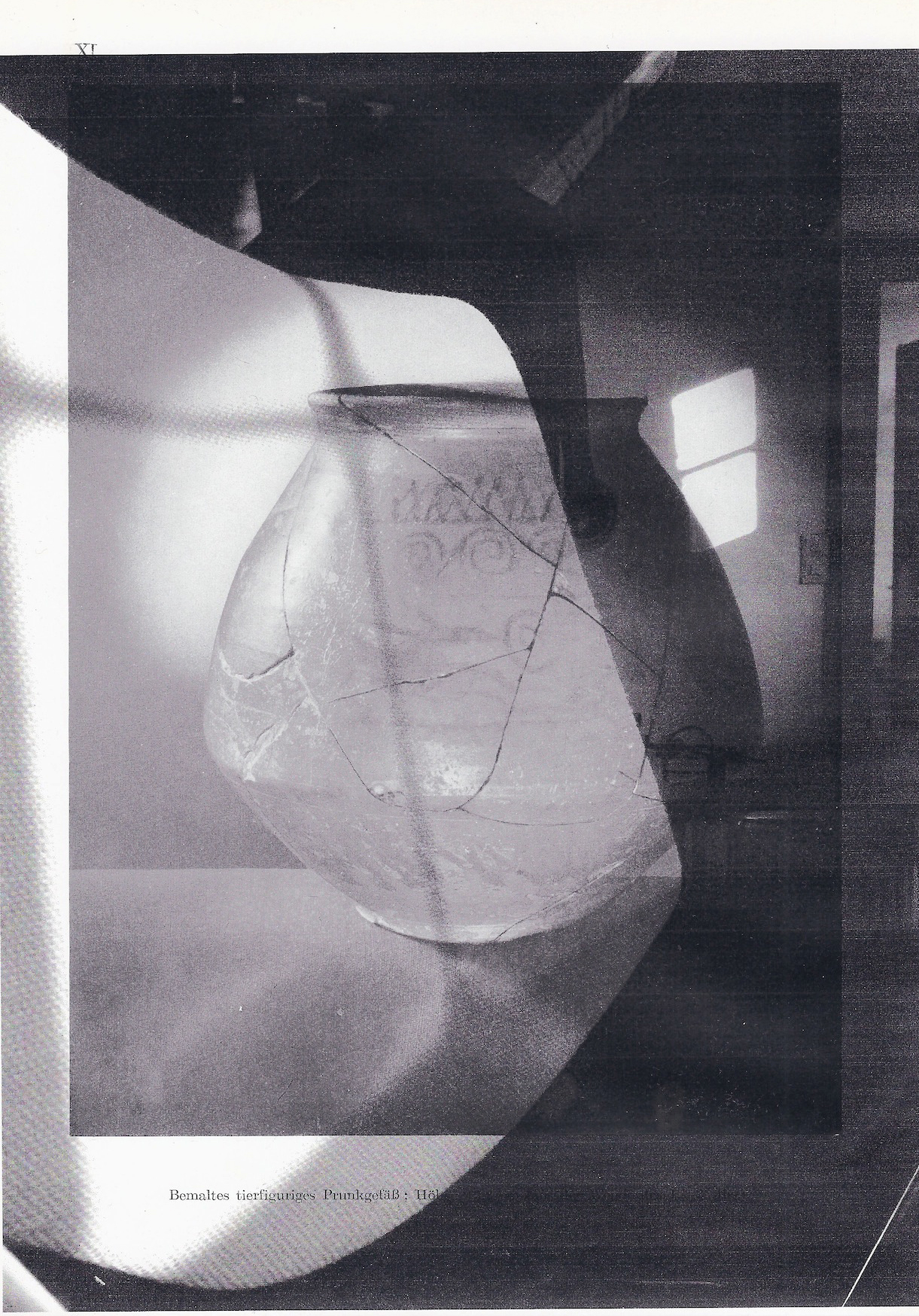MEN AT WORK
2015
Marble is very difficult to keep once it’s discovered. It is a simple material and we should be so careful when we find some marble.
So no more ideas about marble. Today we use it for bathrooms and normal things but I don’t have more ideas about the past in my mind.
I don’t know much about Minoan civilization and I haven’t read much about Minoan art but it happened that I went to Crete twice this year. In July I was on vacation with a friend; two month later I had a stop over for twenty-two hours on my way from Istanbul to New York. Even though Museums were not the main part of both of my trips I went to different archaeological museums each time. The one in Chania is not big but rather charming. You are not allowed to photograph six objects that are on display because they haven’t been officially photographed till now.
The same happened in Heraklion. The guard pointed out four objects that haven’t been published yet and therefore they were not allowed to be photographed. The archaeological Museum in Heraklion is way bigger than the one in Chania and was established already in 1883. It shows next to the Lily Prince also the Snake Goddess, bulls, dancing priestesses and acrobats on animals. Unfortunately the institution in the heart of the local capital is not the most critical house. However the objects are so clear and precise that I forgot the surroundings and the atmosphere. The pure archaic honesty caught my attention for hours and it took me a while to get irritated by colours that were a bit too strong and figures under too perfect conditions for 3000 years of existence.
The museum was founded before Arthur Evans discovered Knossos at the beginning of the 20th century. At that time Crete had gone through different periods. After the Minoan empire Athens took over before the Romans conquered the island. After the fall of the West Roman Empire Crete stayed with Constantinople and experienced once again a cultural blossoming. After the collapse of the Byzantine Empire Crete became part of Venice until the Ottoman Empire governed the island till end 19th century. After several liberation wars the island is now part of the Greek Republic. You see parts of this eventful history everywhere but the focus is on the Minoan period. The cultural self image of Crete is reduced to Knossos.
When Arthur Evans and his team began digging on March twenty-third 1900, within a week they discovered artefacts that Evans diagnosed as artworks from the golden years of Knossos, around 1700 B. C. He was sure he had found the mystical and legendary palace of king Minos and his discovery was an inspiration for a whole generation. Thomas Mann wrote about it in “Joseph und seine Brüder” and art-deco interior designers got inspirations from Minoan patterns. But the artefacts Arthur Evans found are leftovers and leave a lot of scope for interpretation. There has never been a pool of dolphins or dancing girls. Evans put pieces of several frescos together and made a new work out of it. The palace of Knossos was not originally restored but rather constructed the way Evans thought it had looked like. There is nothing wrong about it but it is good to know and to be aware that things are not as easy to read as they seem to be.
On my trip to Heraklion I was reading Edward Said’s “Orientalism”, published in 1978. In the book Said analyzes how western intellectuals invented the idea of Orientalism and patronized a whole region due to fictional descriptions. Ignoring historical facts western politicians and scientists projected an idea on very different cultures with different backgrounds and independent traditions. Depending on your point of view you see different things. There is no right way to look at the past. Every presence writes its own history – over and over again. The canon is flexible and heroes come and go. There is no reality, in fact there are several.
My name is Housen and I am a student at the Faculty of Archaeology, University of Aleppo. As an archaeologist you are connected to a lot of people from all over the world and my hope was to work in different places and get in touch with different cultures and countries. My choice to study archaeology was based on the belief that history will exist and must be protected and discovered. The story of Syria is the story of civilization; Syria is the homeland of civilization. To understand life you need to know the past. I will write more. Thanks Housen
Housen came to the Wesel beginning of June. We got in touch a month later. We met for coffee and talked about the things we have in common.
When I started at university I had no clue but respect and didn’t know how to deal with all the different topics. After a while I started to adore it. The most beautiful moments were the visits to archaeological places. I got to know my country, such as صن الفرسان in Homes and Ugarit in Latakia and Idlib and other المدن المنسية forgotten cities. We worked in groups, which I really liked. The best thing was when we learned about exploration and the detection of objects. We were working in an archaeological excavation and it was wonderful when we discovered cuneiform writings bearing numbers and fees.
The most important tool for detection and excavations are your eyes. It is not all about modern technology because experience is more reliable in the world of archaeology. You need the eyes and the experience you are confronted with many different pieces some fake, some original. Only your eyes and hands can estimate the importance of an object.
Each artefact tells the story of its discovery and restoration. To understand the full meaning, objects should stay with the monuments and remain in the archaeological site. They date back thousands of years and are the key to civilization.
But we don’t know how to save them. Some stupid people think that an archaeologist like Khaled E-Assad threatens Islam and artefacts are dangerous to the community. A history that is thousands of years old gets destroyed. Our history gets killed. I guess they do not want the country to progress….just want to spread ignorance and dirty habits.
Dirty habits, religious fanaticism and irrational behaviour are clichés Edward Said writes about in “Orientalism”. In the 19th century European gentlemen travelled to the Middle East to find these prejudices and were disappointed by reality. Only Flaubert caught syphilis in Egypt. The idea of Orientalism has its background in literature. Imaginations are more important than facts. Images are projected on countries and regions that deal in a different way with images than western society does.
Today it seems as if the barbarians of our imagination have become real. Like a nightmare that steps out of the dreams and starts acting like a real being. Who let the genie out of the bottle? Has that anything to do with Orientalism? Have literary concepts created political facts that are out of control now? I asked Housen what he thinks of Orientalism.
Can you explain what you mean with this question?? Thanks.
This fictional idea by Europeans of “the East”, trying to classify the region from Constantinople via Syria, Egypt, Palestine and India to Mongolia. The imagination of wild sexuality, the harem, homosexuality, intersexuality, drug experience, hallucinations etc. It was based on pure imagination but had a huge impact on politics and the way Europeans still see the Middle East.
Let me think about this question. But…don’t know how to explain…but I will… well… We formed a habit of hiding. People who take drugs hide it and sexuality is hidden anyway. It’s clear that homosexuality has been part of the Middle East for centuries. Today millions of homosexuals live in the East but society doesn’t accept them and public campaigns and executions scare young people to live their lives.
In the province Idlib in Syria antique men were found in an intimate position in a common grave. The discovery was hidden and it is not allowed to speak about the truth.
Today historical places and archaeological structures are getting destroyed by a group of people who claims to speak for all Muslims. They try to kill our history. Aleppo was famous for its wonderful castle and people form all over the world came to enjoy the ruins. Ruins that date back thousands of years are now in the hand of ISIS.
In my opinion, if the world doesn’t do anything to stop this barbarism and brutality of the war, the history of Syria will go away. We lose a great civilization and the knowledge about it. With archaeologists we lose expertise and a whole encyclopaedia. The entire civilization and history of a country gets eliminated. We should think and focus – stop the political problems and care about the history and the culture of generations.
History of mankind is not a history of success. It’s a history of failure and misunderstanding. It’s a story of endless destruction. We are not good in keeping our heritage together. Sometimes we reconstruct things but we make sure it gets destroyed after a while. It happens everywhere, independent from religions or continents. Sleeping beauties only exist as leftovers.
Housen Shikho, Christoph Westermeier, 2015
MEN AT WORK
wood, inkjet prints, offset prints, glass, audio, projection, 2015
Installation view “Men at work”, Schloss Ringenberg,
Single images “Men at work”, projection, printed, 20x28 cm















Recent